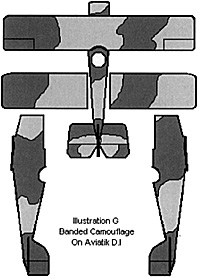
Colors
Until mid-1917, aircraft were normally delivered in natural finish. After that time, several distinct types of camouflage were used, factory-applied to aircraft tops and sides. Unless otherwise noted, under surfaces remained clear-doped. The schemes included:
a. Mottled. This was widely used (except on Phonix, Oef., Fisch., and MAG aircraft) and consisted of a base coat of mustard yellow with terra cotta and medium green blotted onto it with paint-soaked sponges, resulting in a rough, hand-mottled look (just about what one would expect from a gamer hand-painting miniatures!).
b. Streaked. Aviatik fighters often wore a base coat of light tan, with medium brown streaked (dry-brushed, in game-speak) diagonally over it. This pattern might also have medium green streaked over the first two colors.
c. Swirled. Phonix fighters carried a swirl pattern of medium brown or dark green, applied with a paint-soaked sponge held against the aircraft's (clear-doped) surface and twisted, producing a tight swirl pattern. In miniatures terms, this would be accomplished by heavily dry-brushing the brown or green over the base color.
d. Green mottle. Oef. Albatros D.IIIs carried this scheme from mid-1918. It involved several different greens - all of the listed dark greens, for example - dappled over the clear-doped base color in small, distinct, splotches.
e. Lozenge patterns. Starting in late 1917, almost all manufacturers applied some form of lozenge pattern to their aircraft at some time. The lozenges were regular hexagons and were larger than the equivalent German lozenges. These weren't color-printed fabric patterns as were the German lozenges, but were hand painted onto each aircraft before delivery. Colors varied from manufacturer to manufacturer and as color supplies were available, including various browns, terra cottas, yellows, and greens. Unfortunately, due to the wide variety employed, details of these patterns are outside the scope of this article. See Peter Grosz' book, Austro-Hungarian Army Aircraft of World War One, in the bibliography, for more details.
f. Banded. These came into use in 1918 as a simpler alternative to lozenge pattern painting. The base color was typically yellow-gray and the dark green bands might be smooth-edged (akin to British WW II fighters) or serrated-edged (akin to splinter-camouflaged German WW II fighters). One variant sported a blotchy edge that appeared to be sponge-applied.
Recent research (Windsock Vol. 12/5) indicates that the green and yellow-gray mayn't have been those colors at all, but were actually dark gray and gray, respectively. The apparent (green and yellow-gray) colors seem to have been the result of chemical decomposition and yellowing of the original protective varnishes applied to surviving aircraft when they were originally painted 80 years ago. The net result is that air superiority gray-tones may have been in use long before we ever suspected! As research on this matter is ongoing, take your pick - green/yellow-gray or dark gray/gray…
g, Pattern-printed. Some late model Oef. Albatros D.IIIs carried a patterned fabric with red brown and dark green swirls over a yellow-gray base. It's effect was somewhat like a paisley pattern. The reader should go to Grosz' book on Austro-Hungarian aircraft for an illustration. I'm not sure of the practicality of this one for gaming - it's simply too tidy to fake and is really quite pretty…
h. Field applied. Field units whose aircraft predated mid-1917 frequently applied their own camouflage using whatever browns and greens were available, in mottled, splotched, and banded schemes. You should consult whatever photos you can get for authenticity, or failing that, at least be a bit restrained in application - remember: these patterns were meant to camouflage, not advertise!
The Austria-Hungarians used a number of Fokker monoplanes. Most remained in their original clear-doped finishes (see German notes, below), but some apparently were painted medium green overall.
Markings
Until mid-1915, aircraft carried variations on the theme of wide red-white-red stripes at the wing tips, and rudders painted in red-white-red vertical stripes. After October 1915, the cross patée (illustration C1) replaced the stripes on the wings, rudder, and, sometimes, fuselage. The crosses appeared both with and without white bandages or outlines, depending on the background color against which they were applied. Uniquely, the wing crosses were applied midway out the wing and not at the wing tips as with most other nationalities. After April 1918, the Greek cross (illustrations C2 and C3) began to replace the cross patée and the crosses moved out to the wing tips. Serial numbers appeared in black on the fuselage sides. Personal markings were not usual, but they did appear from time to time on the fuselage sides (or over the entire fuselage, such as ace Godwin Brumowski's Oef. Albatros D.III with its all-red fuselage).
More WWI Air Wargaming
-
WWI Air Wargaming Introduction
WWI Air Wargaming 1/300th Scale
WWI Air Wargaming 1/144th Scale
WWI Air Wargaming Painting, Markings, and Colors
WWI Air Wargaming France: colors and markings
WWI Air Wargaming Britain: colors and markings
WWI Air Wargaming Germany: colors and markings
WWI Air Wargaming Austro-Hungary: colors and markings
WWI Air Wargaming Italy: colors and markings
WWI Air Wargaming Russia: colors and markings
WWI Air Wargaming Belgium: colors and markings
WWI Air Wargaming Turkey: colors and markings
WWI Air Wargaming United States: colors and markings
WWI Air Wargaming Colors Chart (extremely slow: 600K)
Back to Table of Contents -- Courier #75
To Courier List of Issues
To MagWeb Master Magazine List
© Copyright 1998 by The Courier Publishing Company.
This article appears in MagWeb (Magazine Web) on the Internet World Wide Web.
Other military history articles and gaming articles are available at http://www.magweb.com